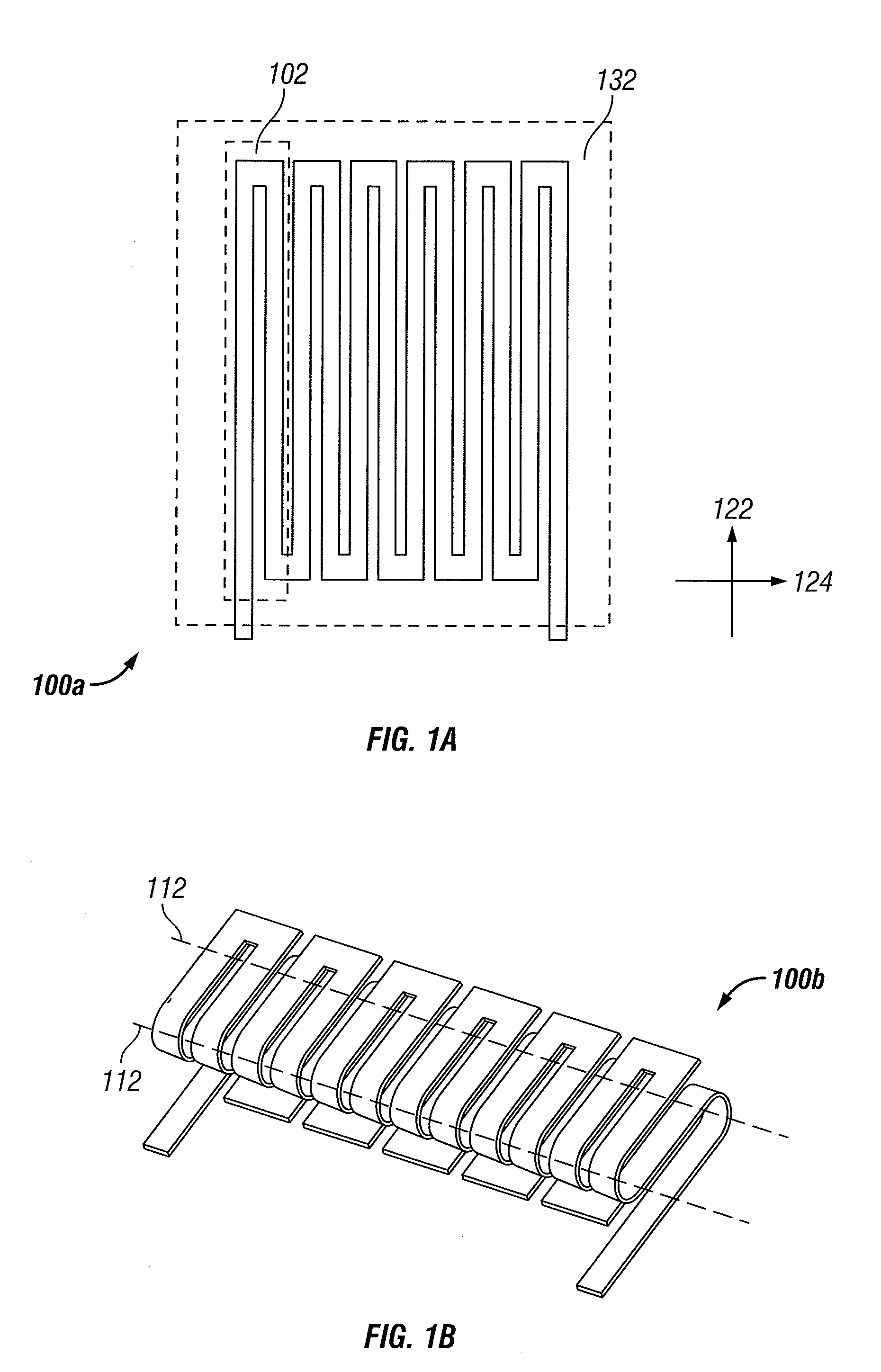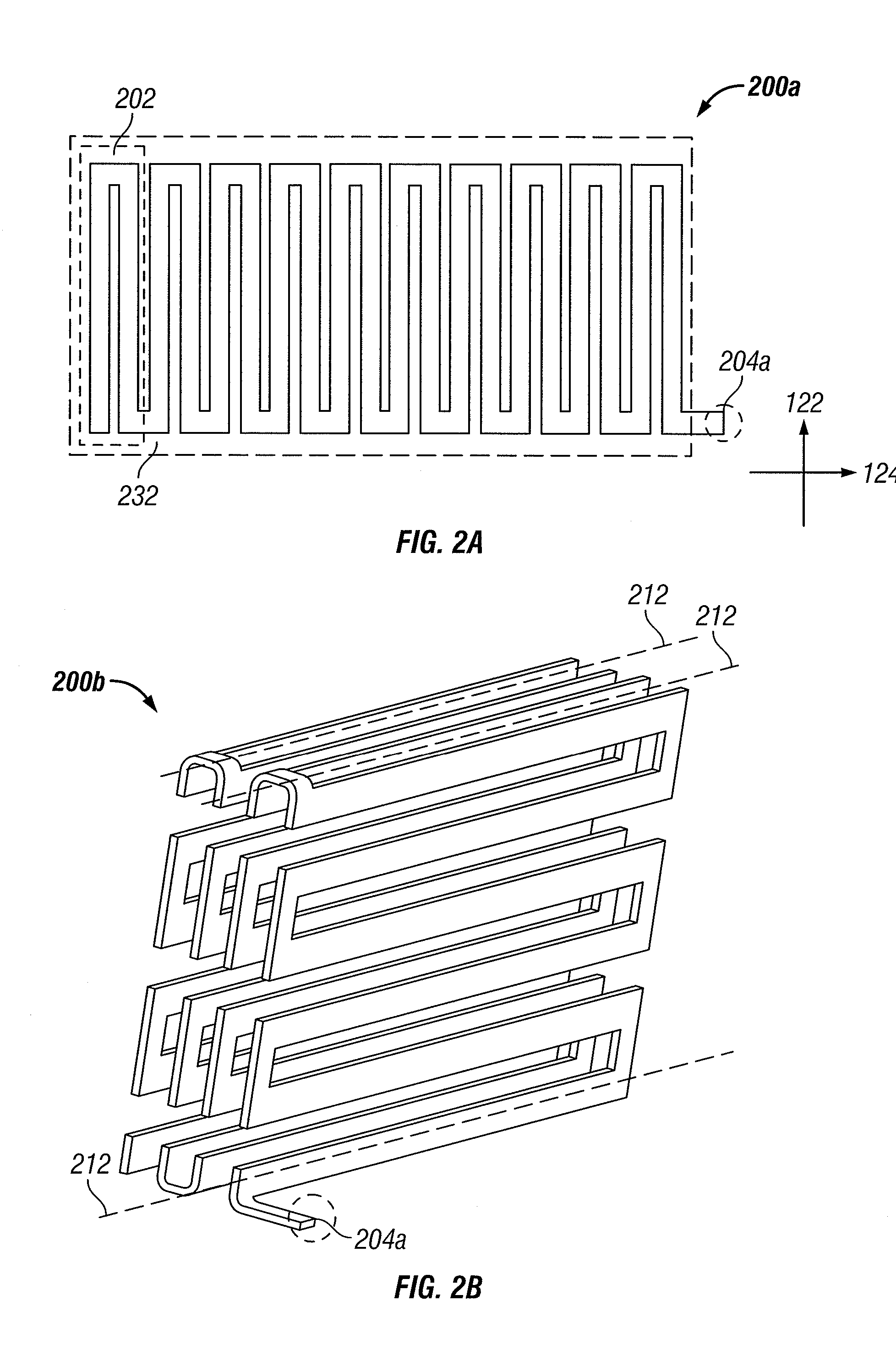Chip Antenna
a chip antenna and antenna technology, applied in the field of antennas, can solve the problems of not meeting the characteristic requirements of the new generation, conventional chip antennas, and small size, and achieve the effects of high manufacturing cost, high manufacturing process, and high cos
- Summary
- Abstract
- Description
- Claims
- Application Information
AI Technical Summary
Benefits of technology
Problems solved by technology
Method used
Image
Examples
first embodiment
The First Embodiment
[0048]FIG. 1A illustrates a schematic view of a flat antenna body of the first embodiment of the invention, and FIG. 1B illustrates a schematic view of a three-dimensional antenna body formed by folding the flat antenna body in FIG. 1A. As illustrated in FIG. 1A, a flat antenna body 100a comprises multiple meandered lines 102 arranged in a direction 124, and the meandered lines 102 are electrically connected in series to form a meandered line set 132. The meandered line set 132 can be formed by punching a conductive sheet, such as continuously punching a copper sheet, or by etching a conductive sheet.
[0049] Next, the meandered line set 132 is folded in a direction perpendicular to the direction 124, i.e. the direction 122. As illustrated in FIG. 1B, the meandered line set 132 is folded with respect to a folding line 112, thus forming a three-dimensional antenna body 100b. The three-dimensional antenna body 160b is a horizontal antenna structure, which is thin, t...
second embodiment
The Second Embodiment
[0050] The second embodiment explains another three-dimensional antenna body, in which the folding direction thereof is different from that of the first embodiment.
[0051]FIG. 2A illustrates a schematic view of a flat antenna body of the second embodiment of the invention, FIG. 2B illustrates a schematic view of a three-dimensional antenna body formed by folding the flat antenna body in FIG. 2A, and FIG. 2C illustrates a schematic view of a chip antenna formed by encapsulating the three-dimensional antenna body in FIG. 2B in a packaging material.
[0052] As illustrated in FIG. 2A, a flat antenna body 200a comprises multiple meandered lines 202 arranged in a direction 124, and the meandered lines 202 are electrically connected in series to form a meandered line set 232.
[0053] The major difference between the first and the second embodiments is their folding directions of their meandered lines, and thus, their radiating properties. In the second embodiment, the me...
third embodiment
The Third Embodiment
[0057] The third embodiment describes an antenna body with different sets of meandered lines. The meandered lines of different sets can be applied with different folding manners, such as folding lengths and angles, to form a three-dimensional antenna body.
[0058]FIG. 3A illustrates a schematic view of a flat antenna body of the third embodiment of the invention, and FIG. 3B illustrates a schematic view of a three-dimensional antenna body formed by folding the flat antenna body in FIG. 3A. As illustrated in FIG. 3A, a plurality of the first meandered lines 302 are arranged in a direction 122, and the first meandered lines 302 are electrically connected in series to form a first meandered line set 332. A plurality of the second meandered lines 304 are arranged in a direction 122, and the second meandered lines 304 are electrically connected in series to form a second meandered line set 334. The first meandered line set 332 and the second meandered line set 334 are ...
PUM
 Login to View More
Login to View More Abstract
Description
Claims
Application Information
 Login to View More
Login to View More - R&D
- Intellectual Property
- Life Sciences
- Materials
- Tech Scout
- Unparalleled Data Quality
- Higher Quality Content
- 60% Fewer Hallucinations
Browse by: Latest US Patents, China's latest patents, Technical Efficacy Thesaurus, Application Domain, Technology Topic, Popular Technical Reports.
© 2025 PatSnap. All rights reserved.Legal|Privacy policy|Modern Slavery Act Transparency Statement|Sitemap|About US| Contact US: help@patsnap.com



